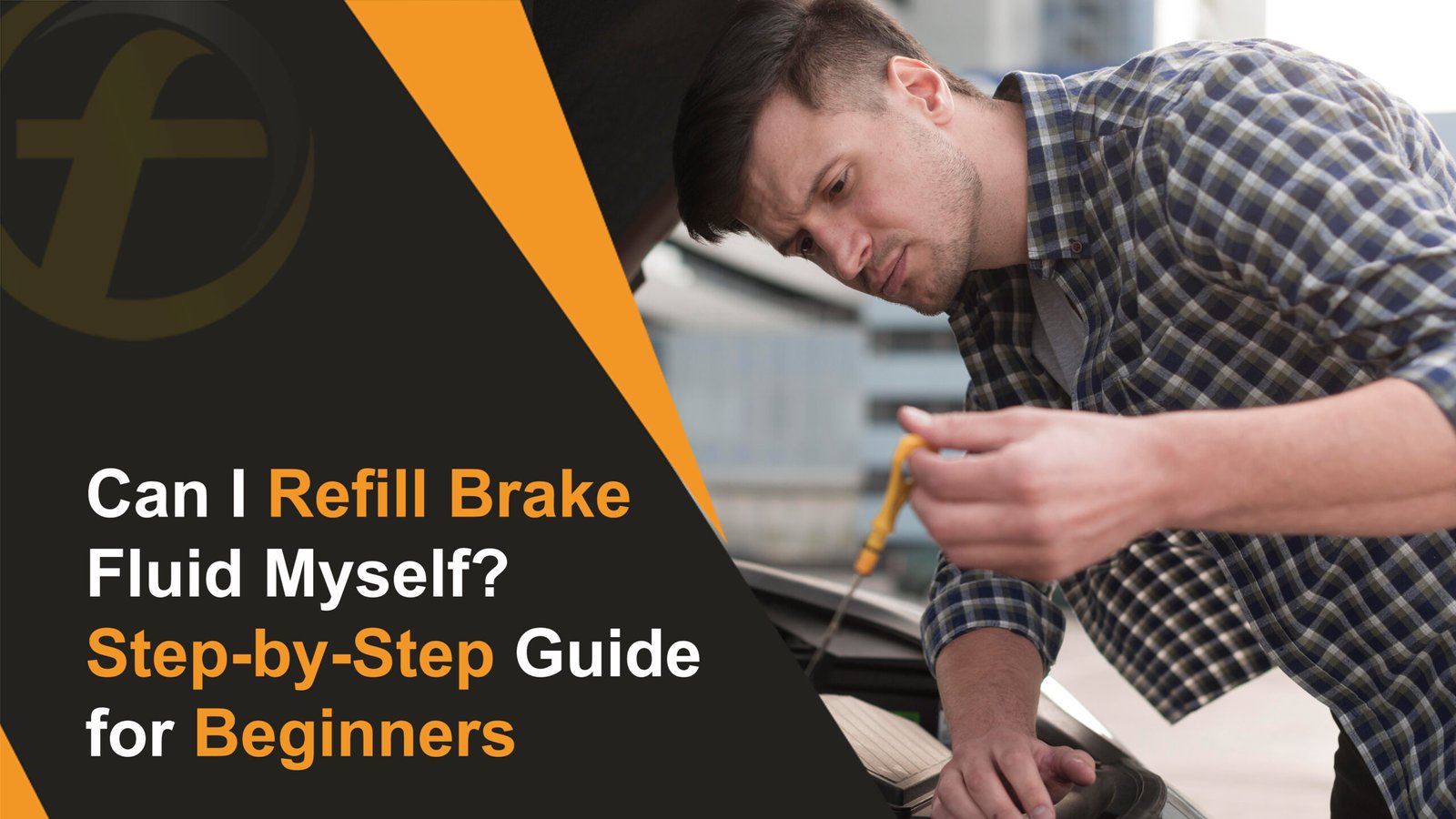
Ever pressed your brake pedal and felt it go soft or unsteady? That could mean your brake fluid needs attention! Brake fluid plays a big role in helping your car stop safely — without it, your brakes can’t do their job properly. The good news is that refilling or changing brake fluid isn’t as hard as it sounds. With the right tools, a bit of care, and some simple steps, you can do it yourself at home.
At Fubex Lubricants, we offer high-quality brake fluid for all types of engines. Enjoy fast shipping, a price match guarantee, and no-questions-asked returns. Need help choosing the right oil? Call us at +971 50 544 9614 — our friendly team is ready to assist!
In this guide, we’ll walk you through everything — from understanding what brake fluid does, to spotting signs it needs changing, to a step-by-step method for refilling it safely. Whether you’re a beginner or just want to save a trip to the mechanic, this easy guide will help you keep your car’s brakes strong, smooth, and ready for every drive.
What is Brake Fluid?
Brake fluid is a special liquid that helps your car stop safely. When you press the brake pedal, the brake fluid carries that force to the brake pads, which then press against the wheels to slow down or stop your car.
This fluid is usually made from a mix of glycol and water. The glycol keeps it from freezing, and the water helps stop it from boiling when things get hot.
It’s very important to use the right kind of brake fluid for your car. Using the wrong one can damage your brake system and make it unsafe to drive.
Signs You Need to Change Your Brake Fluid
There are a few signs that show your brake fluid might need to be changed:
- The brake pedal feels soft or spongy
- You see fluid leaking from the brakes
- The brake pedal comes back up slowly
- The brake fluid level is low
- The brake pedal feels hard to press
- Your brakes don’t work as well as before
If you notice any of these problems, it’s best to have a skilled mechanic check your brakes. They can tell you if your brake fluid needs to be changed.
How Often Should You Change Your Brake Fluid?
Most car makers say you should change your brake fluid every 2 years or after driving about 24,000 miles — whichever comes first.
But if you often drive in heavy traffic or in tough conditions that make you use your brakes a lot, you may need to change your brake fluid more often.
Also Read: How Often Should Brake Fluid Be Changed in Cars and Motorcycles?
A Step-by-Step Guide to Changing Brake Fluid
- Get Ready to Work: Find a clean, flat place to work. Gather everything you need — new brake fluid, rags, gloves, a funnel, and a wrench set.
- Find the Brake Fluid Reservoir: Open your car’s hood. The reservoir is usually near the back of the engine and may have a small cover on top.
- Remove the Old Brake Fluid: Use a funnel to carefully pour the old fluid into a container. Don’t dump it anywhere — brake fluid can harm the environment, so dispose of it properly.
- Clean the Reservoir: Wipe the inside with a clean rag to remove any dirt or leftover fluid.
- Add New Brake Fluid: Using a funnel, pour in fresh brake fluid until the reservoir is full. Always use the type of brake fluid your car’s manual recommends.
- Close the Cap: Put the reservoir cap back on tightly to keep dirt and air out.
- Bleed the Brakes: This step helps remove air from the system. Ask a friend to press the brake pedal while you open the bleeder valves. When fluid starts to come out, close the valves and have your friend keep pumping until the pedal feels firm. Repeat until all the air is gone.
- Test Your Brakes: After bleeding, drive slowly around the block. Try stopping a few times to make sure your brakes feel strong and smooth. If everything feels right, you’re done!
Why Flushing Brake Fluid is Important
- Prevents Brake Failure: Your brakes work using pressure from brake fluid. Over time, the fluid can absorb moisture, which lowers its boiling point. When this happens, the fluid can turn into vapor during heavy braking — making your brake pedal feel soft or even sink to the floor. If this happens, it’s best to get your brakes checked by a professional to stay safe.
- Protects Brake Parts: Old or dirty brake fluid can cause rust and damage inside your brake system. Moisture and dirt can harm important parts like the calipers, cylinders, and ABS system. Flushing out the old fluid helps protect these parts and saves you from expensive repairs.
- Keeps Brakes Working Smoothly: Fresh brake fluid keeps the pressure strong, so your car stops quickly and smoothly when you press the pedal. This is extra important in emergencies when you need your brakes to respond fast.
How Often Should You Flush Your Brake Fluid?
Most car makers suggest flushing your brake fluid every 2 to 3 years or about every 30,000 miles — whichever comes first. But this can change depending on your car type and how you drive.
Signs You Need a Brake Fluid Flush
- Brake pedal feels soft or spongy
- Brake fluid looks dark brown or black
- ABS warning light is on
- Strange noises when braking
- Brakes don’t work as well on long drives
How to Check Your Brake Fluid
Open the brake fluid reservoir under the hood and look at the fluid. Good brake fluid should be clear or light yellow. If it’s dark, cloudy, or dirty, it’s time for a flush. Also, check the fluid level — it should be between the “MIN” and “MAX” lines. If it’s low, there might be a leak or your brake pads may need checking.
Also Read: What Happens If You Never Replace Brake Fluid – Quick Guide!
Tools and Materials You’ll Need
Essential Tools
Before you start changing your brake fluid, make sure you have all the right tools ready. You’ll need:
- A jack and jack stands to lift and safely hold your car.
- A lug wrench to remove the wheels.
- A brake bleeder kit or a wrench to drain the old brake fluid.
- A turkey baster to take old fluid out of the master cylinder.
- A catch container to collect old fluid and avoid spills.
- A funnel to pour in new brake fluid without mess.
- A work light or torch so you can see clearly under the car.
Having everything ready before you start will make the job easier and safer. Use the right products for the best results. Most cars work well with DOT 4 brake fluid, but always check your car’s manual first. Using good tools and the right brake fluid will make the job smoother and more reliable.
Preparing Your Workspace
Before starting, find a flat and stable place like your driveway or garage floor. Clear away clutter so you can move around easily. Lay down newspapers or an old sheet to catch spills. Keep all your tools nearby so you don’t have to stop and look for them later.
Make sure you have good lighting and fresh air while working. A clean, organized, and well-lit workspace will make changing your brake fluid much safer and faster.
Common Mistakes to Avoid When Changing Brake Fluid
Overfilling or Underfilling
Keeping the right amount of brake fluid is very important. If you overfill the reservoir, the extra fluid can build up too much pressure and cause leaks or damage when it expands from heat. But if you don’t fill it enough, air can get into the brake lines, making the brake pedal feel soft and weak.
Always check your car’s manual and use the “MIN” and “MAX” marks on the reservoir as a guide. Keep checking the level while bleeding the brakes to make sure it stays right.
Ignoring Air Bubbles
Air bubbles in the brake lines are a big problem. Air can compress, but brake fluid cannot — so if air gets in, your brakes won’t work as well. This makes the brake pedal feel spongy or slow to respond.
While bleeding the brakes, watch for bubbles coming out of the bleeder valves. If you still see bubbles, keep going until the fluid runs smoothly and clear. Start from the wheel farthest from the master cylinder. Make sure the fluid level doesn’t get too low, or air will enter the system again.
Using the Wrong Type of Brake Fluid
Always use the correct brake fluid type for your car — usually DOT 3, DOT 4, or DOT 5.1. Mixing the wrong kinds can cause serious problems. DOT 3 and DOT 4 can be mixed, but DOT 5 is silicone-based and should never be mixed with the others.
Using the wrong fluid can damage rubber parts in your brake system and make your brakes less effective. Check your car’s manual to see which type is recommended.
By avoiding these mistakes, you’ll help keep your brakes strong, safe, and working the way they should.
Also Read: Can You Use Brake Fluid For Power Steering Fluid?
Final Takeaways
Changing or refilling your brake fluid may sound tricky, but with the right tools and a little patience, it’s something you can do yourself. Keeping your brake fluid clean and at the right level helps your car stop safely and protects your brake parts from damage. Always use the correct type of brake fluid, follow your car’s manual, and check for leaks or air bubbles.
Regular brake maintenance not only saves you money but also keeps you safe on the road. So take your time, stay careful, and make sure your brakes are always ready when you need them most.
FAQs
Q1: How long does brake fluid last before it needs replacement?
You should replace your brake fluid every 2 to 3 years, or after driving about 24,000 to 45,000 miles, depending on what your car’s maker recommends. This is important because brake fluid absorbs moisture from the air over time. When that happens, it can’t handle heat as well and might cause your brakes to stop working properly.
Q2: Can I add brake fluid without flushing it?
Yes, you can add brake fluid if the level is low. Just make sure to use the correct type and fill it up to the “MAX” line.

Editor-at-Large
A passionate writer in the lubricant industry, Awais Iqbal has been covering oils, greases, and industrial fluids since the start of his career. At 25, he’s already written for blogs, catalogs, and brand guides across the UAE. Awais’s insights help companies connect with their audience, and his clear, helpful writing style is trusted by brands in the region.


